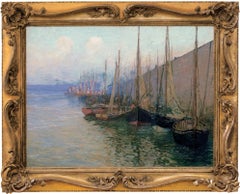Lilian Mackendrick Art
Lilian MacKendrick was a natural-born artist. MacKendrick had a talent that was intuitive and searching artistic intellect. The daughter of Russian emigrants, MacKendrick grew up in the art world of New York's Armory Show. A graduate of New York University with a degree in Fine Arts, MacKendrick went on to study sculpture at City College of New York as well as painting at the Art Students League. MacKendrick’s early attempts were in the non-objective field. Despite her tremendous admiration for the great European painters of the 18th & 19th centuries (she copied, as a learning exercise, all the drawings of Goya and Rembrandt in this country). MacKendrick’s tastes, since childhood, were for Oriental rather than American and European paintings which she found too violent. But MacKendrick continued her exploration of the fusion of East and West, arriving at a synthesis that has been described, among other things, as a "recovery of the image." Some of MacKendrick’s work, however, has echoes of the work of the French masters Pierre Bonnard and Henri Matisse; a reference that the artist herself would not find offensive. MacKendrick regularly spent summer vacations in France. Many observers of her work say that her paintings make them feel that life is good again; that there is something wonderful and exciting about the world they are eager to see when they wake up in the morning, and that her paintings are singular and striking. Jane Janson's statement in regards to MacKendrick's 1958 exhibition at Hirschl & Adler Galleries easily applies to some of her painting, "Her range of blazing summer color and exuberant pattern captivates the eye, and lend renewed zest to a realm which has been ignored for a while and to which we return with instinctive delight." "Has seen" is the operative phrase because her works are rarely seen these days, although there are over 400 works in private collections. A devastating flood in MacKendrick’s studio in 1984 destroyed a number of works.
Mid-20th Century American Impressionist Lilian Mackendrick Art
Oil, Canvas
Early 1900s American Impressionist Lilian Mackendrick Art
Canvas, Oil
20th Century American Impressionist Lilian Mackendrick Art
Oil, Canvas
20th Century American Impressionist Lilian Mackendrick Art
Canvas, Oil
1910s American Impressionist Lilian Mackendrick Art
Canvas, Oil
20th Century American Impressionist Lilian Mackendrick Art
Oil, Canvas
1930s American Impressionist Lilian Mackendrick Art
Oil, Canvas
1910s American Impressionist Lilian Mackendrick Art
Oil, Canvas
Early 1900s American Impressionist Lilian Mackendrick Art
Canvas, Oil
20th Century American Impressionist Lilian Mackendrick Art
Oil, Canvas
1910s American Impressionist Lilian Mackendrick Art
Oil, Canvas
1910s American Impressionist Lilian Mackendrick Art
Canvas, Oil
1930s American Impressionist Lilian Mackendrick Art
Canvas, Oil

